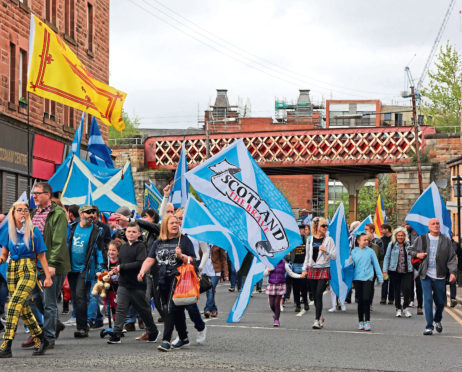Battle lines were drawn last night for a fresh clash over Scotland’s future after the SNP unveiled a new blueprint for independence.
The long-awaited prospectus attempts to spike the guns of many of the No campaign’s key arguments in the run-up the 2014 vote by ruling out a currency union, any bank bail-outs and removing North Sea oil and gas from its economic models.
First Minister Nicola Sturgeon said the 354-page report by the Sustainable Growth Commission, which she set up in 2016, could “replace the despair of Brexit with optimism about Scotland’s future”.
But opponents branded the proposals a “cuts commission” after it recommended a programme to slash the nation’s deficit from 5.9% to 3.% within a decade.
The document signalled a number of policy shifts by the SNP, including on currency, which became a key dispute during the last independence referendum campaign.
Instead of a currency union with the rest of the UK, as previously proposed, the blueprint advocates the continued use of sterling without such a formal arrangement, potentially followed by the creation of a new Scottish currency if six key tests can be met.
However, the commission said the six tests were “unlikely to be met until towards the end of the first decade following a successful independence vote”, and it also did not completely rule out joining the euro if it was required as part of EU membership.
Another change from the previous independence white paper was on corporation tax, which would no longer be set at 3% below the UK rate, with a major reduction now not considered an “optimal strategic tool”, although the headline rate would not rise above that of UK.
A detailed plan for an “annual solidarity payment” to the rest of the UK for servicing of debt, shared services and foreign aid commitments was also unveiled, and it was estimated that it could start at £5.3 billion.
“The tone set by Scotland to the rest of the United Kingdom must be positive, responsible and respectful of the fact that we are the party that is changing the arrangements,” stated the report, which took 2021/22 as its start date for independence.
A saving of £1 billion from current UK spending in Scotland was targeted, as was strict fiscal targets, including that public debt should not rise above 50% of GDP, and that the public sector deficit should be reduced to below 3% of GDP.
“The greater volatility that small economies can experience also strengthens the case for fiscal conservatism,” stated the report, which was titled “The Scotland: A New Case for Optimism”.
However, a fiscal stimulus to growth was also recommended, including a “significant increase” in infrastructure investment the short to medium term.
The report also outlined how more than 4,100 additional civil servants would come under Scottish Government control, as well as an extra 2,500 members of the armed forces, with a defence budget assumed at an initial 1.6% of GDP.
A new defence department and Scottish armed forces would be established, as well as a foreign ministry and diplomatic service, an integrated security and intelligence agency, and a central bank and financial regulator.
It is estimated that setting up these structures would cost £450 million in the two years leading up to independence and the first three years immediately afterwards.
The commission looked at 12 successful independent states but found that “no one existing model can simply be replicated”, with Scotland instead best to learn the lessons from all, with a strategy focusing on a “hybrid of the best” of Denmark, Finland and New Zealand.
The report added that focusing on “a few niche areas” of the economy – such as the energy sector, food and drink, tourism, financial services, science and innovation, digital industries, biotech and education – could “secure economic success”.
Commission chairman Andrew Wilson said: “It is important that independence must never be seen as a magic wand or quick and easy step to success. Indeed, there is no pot of gold, black or otherwise, at the foot of the independence rainbow.
“But there is a toolbox and using it will mean taking responsibility for choices that seek to create a stronger economy, sustainable public finances and a fairer society.”
